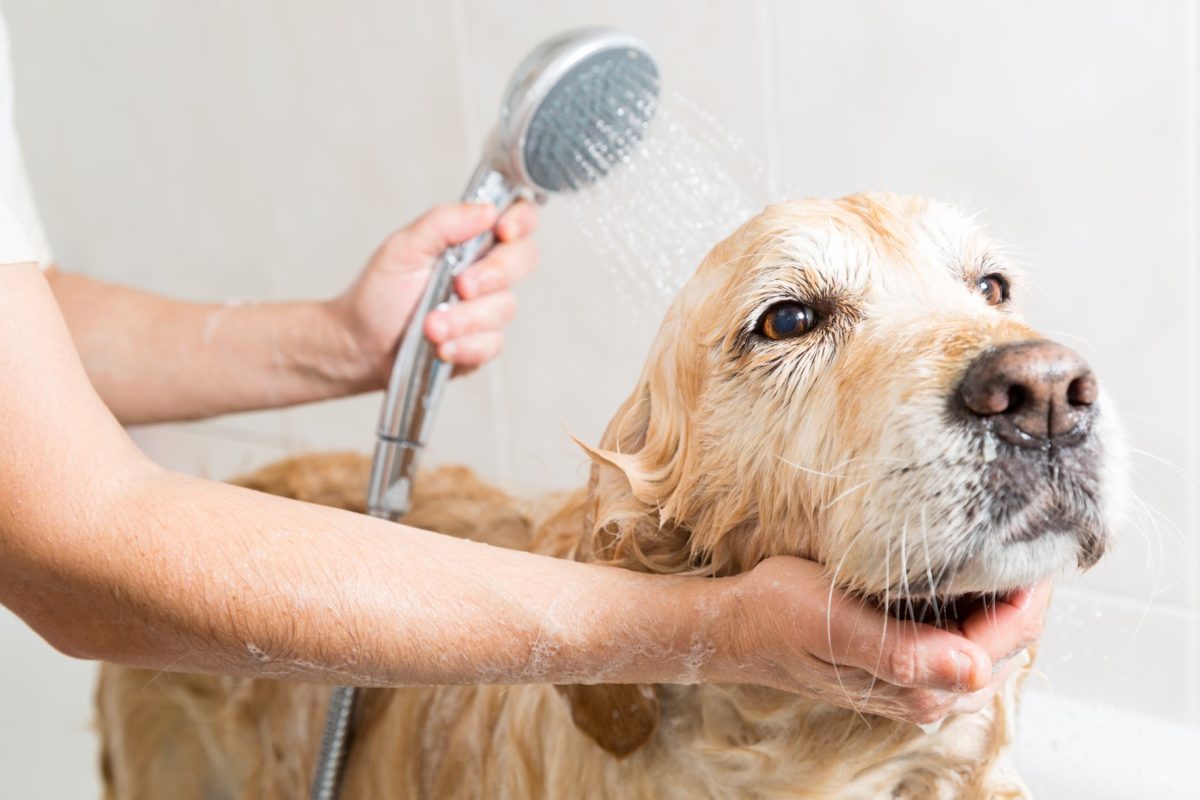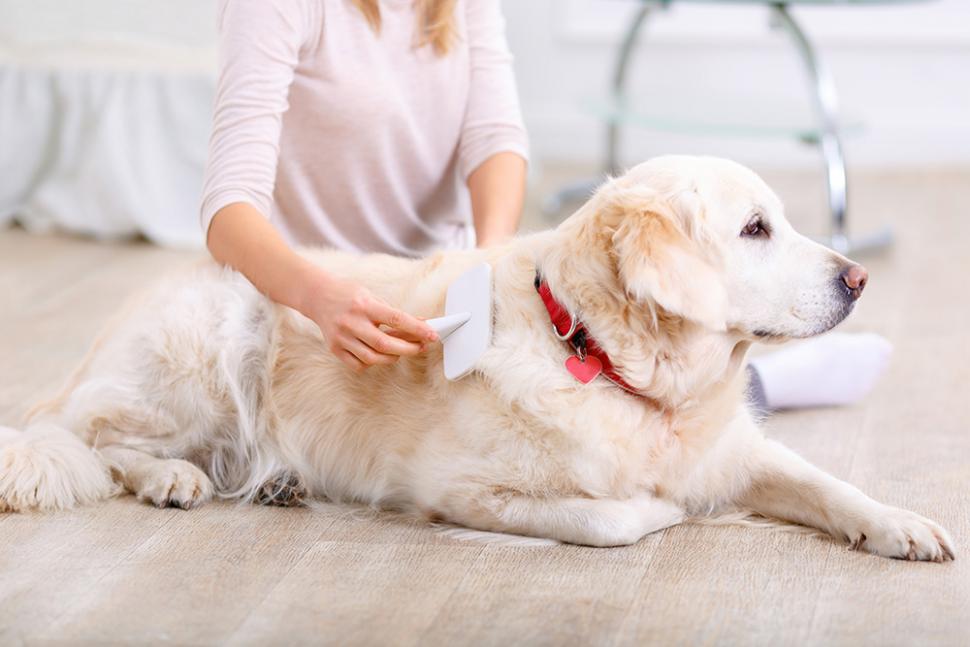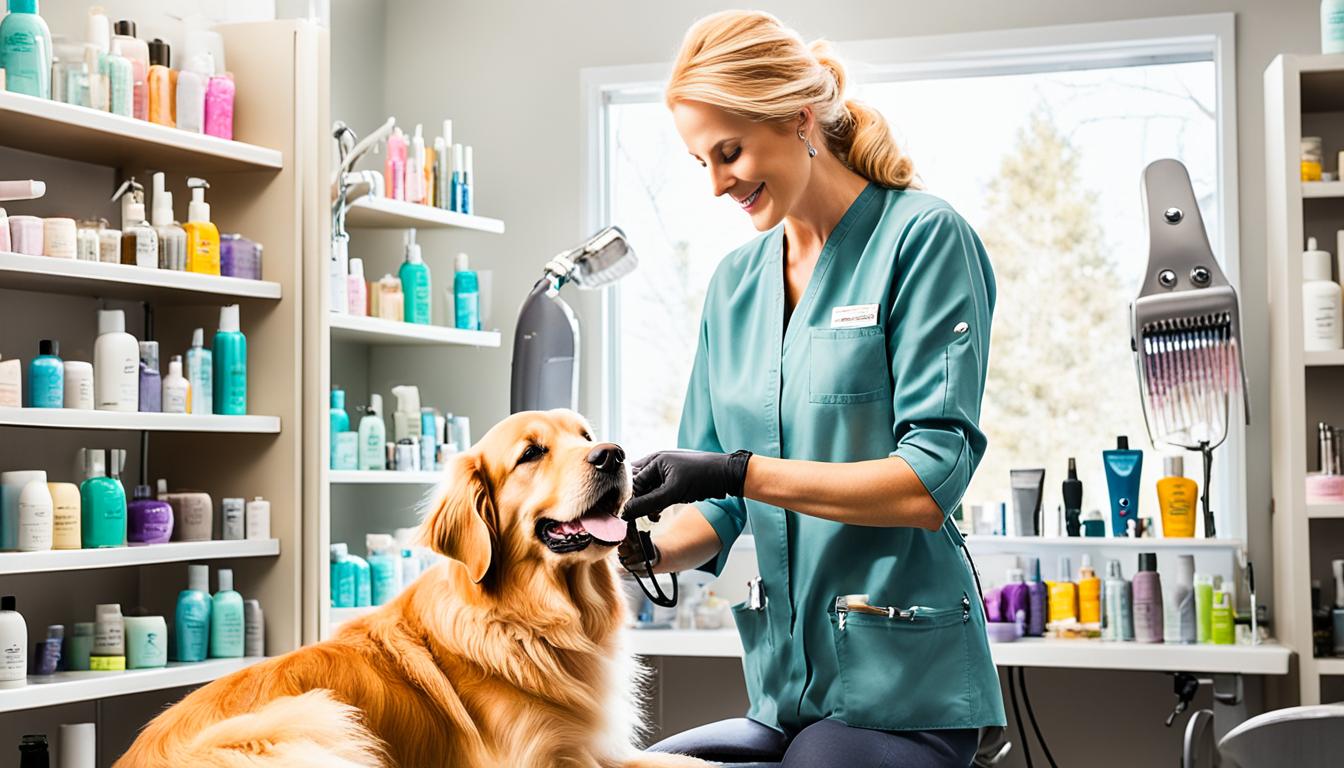
Bathing Your Dog: Tips for a Stress-Free Experience
Bathing your dog doesn’t have to be a stressful event. With a stress-free dog bathing routine, you can make bath time a positive experience. Imagine your pet looking forward to bath time instead of hiding away. But how can you make this happen?
Every three months, dogs need a full groom and cut. Between these visits, a stress-free bathing routine is key. Set aside 30 minutes of your time for a thorough and enjoyable bath. For Golden Retrievers, their double coat needs extra care to stay looking great. But always prioritize your dog’s comfort and dry them well to prevent skin issues.
When choosing treats, avoid those with xylitol or birch sugar, which are harmful to dogs. Milo’s Kitchen® Homestyle Dog Treats are a great choice, made with real meat and available at Walmart. Brushing your dog before the bath helps remove loose hair for a better bath. Rinse off last to help your dog stay calm.
Imagine two hands gently washing your dog, making bath time a calm experience. This teamwork can help your dog feel more at ease. Treats like Milo’s Kitchen® Homestyle Dog Treats can make bath time a positive event.
Having a trusted helper can make bath time even better. The goal is a clean, happy, and relaxed dog. Rinse your dog thoroughly to avoid skin irritation. These steps can make bath time something your dog looks forward to.
Understanding Your Dog’s Bathing Needs
Figuring out how often to bathe your pet depends on their breed, coat type, and lifestyle. For example, Golden Retrievers with water-repellent coats don’t need baths often. This is because their natural oils are important for their coat’s health. On the other hand, Basset Hounds with oily coats might need a bath once a week.
Using tools like bristle brushes for short-haired breeds or wire pin brushes for furry ones makes washing easier. Items like non-slip mats and doggie shower sprayers make bath time safer and more efficient. Small dogs can be bathed in sinks, while bigger dogs need a big tub or outdoor setup.
Regular grooming is key for dogs with long hair, like Poodles or Yorkies. This helps prevent matting and keeps them clean. Getting help from professionals is a good idea for these breeds.

Not all dogs like getting bathed, so using treats can make the experience better. But, don’t give out too many treats. Getting tips from dog experts can help you find the right bathing schedule and method for your dog. This makes bath time less stressful for everyone.
Understanding and meeting your dog’s specific needs makes bathing easier and can even help you bond with your pet. Remember, grooming is important for their health. It lets you check for any health issues that need attention.
Pre-Bath Training for a Fear-Free Experience
Getting your dog gently used to the bath is key for calming dog bath strategies. This method can turn a scary bath into a good experience. Start by letting your dog check out the bath area without water. Put their favorite treats around to make it a positive place.
Next, get your dog used to the sound of running water before the full bath. Reward them with treats and love for staying calm. This helps them get comfortable with the bath sounds.
Brushing your dog before the bath is also a good idea. It removes dirt and gets them used to being touched. Brushing is both practical and calming, helping your dog relax before the bath.
Having someone help during the bath can make it easier. One person can wash while the other keeps the dog calm. This makes the bath safer and less stressful for your dog.
To sum up, making bath time fear-free starts with careful preparation. From slow introductions to getting used to sounds, every step aims to make your dog feel safe and calm.
Assembling Your Dog Bathing Kit
Getting ready with a dog bathing kit makes bathing your dog easy and stress-free. You’ll need dog-friendly shampoo and dog-friendly conditioner to keep your pet’s skin and coat healthy. It’s also key to find the right dog bath accessories for comfort and efficiency.

Many dog owners struggle with the cost of professional grooming. So, making a home kit with the right dog bathing techniques and tools is a smart move. You should have several towels, a non-slip mat, and a handheld shower wand for easy rinsing.
Adding ramps for older dogs and a special tub can make bathing easier, especially for big breeds. These features ensure your pet is comfortable and safe during the bath.
Your station could also have shelves for grooming tools, bottle holders, and towel racks. This keeps everything you need close by. For small spaces, consider elevated basin sinks or adaptable fixtures like dog-friendly shampoo and conditioner bottle holders.
When building a bath setup, use strong, waterproof materials and install fixtures like hand-held shower wands and non-slip surfaces correctly. This makes sure your pet is safe and comfortable, making the bath a good experience for both of you.
Setting up a dog bathing station might take more time and cost more upfront. But, it makes regular grooming easier. It’s not just about keeping your dog clean. It’s also about making the bathing process enjoyable for them with proper dog bathing techniques.
Bathing Your Dog: Step-By-Step Techniques
Bathing your pet can seem tough, but with the right steps, it becomes easy. Start by getting everything ready: dog shampoo, conditioner, cotton balls for the ears, and towels. Since most dogs need a bath every one to two months, tailor your approach to their needs.

Begin by wetting your dog with lukewarm water that feels comfortable. Avoid the ears and eyes, which are sensitive. Use a shampoo made for your dog’s coat and skin type, without artificial colors or fragrances to prevent irritation.
Apply shampoo from the neck to the tail. If bathing outside, use a grooming loop to keep your dog safe and in control. After washing, rinse well to avoid skin problems. For dogs who bath often, use a gentle shampoo and conditioner to keep their coat healthy and prevent dry skin.
The order in which you wash your dog matters. Washing the head last helps prevent water shake-off and reduces stress. Dry your pet with towels, cover furniture to protect it, and give praise and treats for good behavior. This makes future baths easier and more positive.
Bathing your pet is about more than just cleanliness. It’s a chance to bond and understand your dog’s needs. A consistent yet flexible bath routine is key to your pet’s health and happiness.
The Importance of Keeping Calm and Collected
Learning how to use calming dog bath strategies is key for pets and their owners. Start by creating a calm space, which helps lower the stress of bathing. Dogs sense their owner’s feelings, so staying calm is important. This makes baths more fun and helps your dog behave better in the future.
For good dog bath tips, begin with a calm setting. Have all your bath supplies ready before you start to avoid stress. Using a pet dryer with an ear protector can also keep your dog calm by reducing loud noises.
Looking at trusted sources can help improve your dog’s skin and coat care. Focus on gentle handling and positive rewards to make baths a positive experience for your dog.
Actions like using your hands to dry your dog or placing a towel for them to step on show care and safety. These actions help make grooming a positive routine for your dog’s health and happiness.
Maintaining a Regular Bath Routine
A well-done dog bath starts long before the tub. It’s all about the right techniques and consistent habits. This keeps your pet clean and comfortable. Proper water pressure is key, especially for dogs with long hair or sensitive skin.
Not brushing your dog’s coat before a bath can cause tangles and mats. It’s important to know how and when to bathe your dog. BeChewy suggests bathing based on coat length, and the ASPCA recommends daily brushing for long coats and weekly for short ones.
When bathing your dog, use diluted shampoo as directed and rinse gently. This keeps their coat clean without irritating their skin. It’s also important to dry them carefully, especially if they have long fur. Avoid using strong skin oils by not over-bathing them.
The American Kennel Club advises on the best way to dry and care for your dog’s coat. Creating a positive bath time with reassurance and treats can help dogs who are anxious about baths.
Following these tips makes grooming a regular part of your routine. It helps your dog stay clean between baths. For fun after a bath, a bit of peanut butter on the wall can be a great treat. Always check with a vet for the best bathing routine for your dog’s health and coat type.





